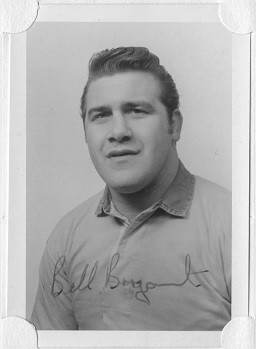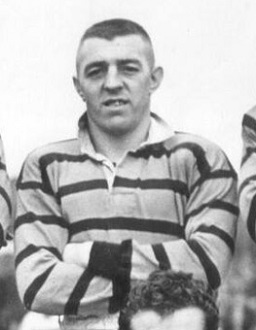Related Research Articles
Leslie "Les" Chamberlain was an English professional rugby league footballer who played in the 1950s and 1960s. He played at club level for Wakefield Trinity, Bramley, Hull Kingston Rovers and Leeds, as a prop, second-row, or loose forward.
Dennis Baddeley was an English professional rugby league footballer who played in the 1940s and 1950s. He played at representative level for Yorkshire, and at club level for Castleford, Wakefield Trinity and Featherstone Rovers, as a wing.
Leslie Sheard is an English former rugby union and professional rugby league footballer who played in the 1970s and 1980s, and coached rugby league in the 1980s. He played club level rugby union (RU) for Wakefield RFC, and representative level rugby league (RL) for England and Yorkshire, and at club level for Castleford, Wakefield Trinity, York (captain), and Huddersfield, as a fullback or centre, and coached club level rugby league for Huddersfield.
William Ramsey was an English professional rugby league footballer who played as a prop, second-row or loose forward in the 1960s and 1970s, and coached in the 1970s. He played at representative level for Great Britain, Yorkshire, and Commonwealth XIII, and at club level for Hunslet F.C., Leeds, Bradford Northern, Hull FC and Widnes, and coached at club level for New Hunslet. During his Leeds career Ramsey appeared in 17 major Finals, including five at Wembley Stadium, London, scored a rare drop goal in the 1969 Championship Final, toured twice in 1966 and 1974, and won seven winners medals with Leeds.
Dennis Hartley was an English professional rugby league footballer who played as a prop in the 1950s, 1960s and 1970s.

Kenneth "Ken"/"Jubby" Jubb was an English professional rugby league footballer who played in the 1930s and 1940s. He played at representative level for Great Britain, England and Yorkshire, and at club level for Castleford and Leeds, as a second-row. Jubb was a sergeant major in the British Army during the Second World War.

James Arthur Bacon was a Welsh rugby union, and professional rugby league footballer who played in the 1910s, 1920s and 1930s, and coached rugby league in the 1920s. He played club level rugby union (RU) for Cross Keys, and representative level rugby league (RL) for Great Britain, Wales and Monmouthshire, and at club level for Leeds (captain), and Castleford, as a wing, or centre, and coached at club level for Castleford.
Ken Eyre was a professional rugby league footballer who played in the 1950s, 1960s and 1970s. He played at representative level for Great Britain, and at club level for Hunslet, Leeds and Keighley as a prop. As a child Ken represented Bewerly Street school, Hunslet Schools' R.L. and Yorkshire Schools R.L.

William Bryant, known as "Big Bill", was an English professional rugby league footballer who played in the 1950s, 1960s and 1970s. He played at representative level for Great Britain and Yorkshire, and at club level for Castleford, as a second-row.
David Apatu Plange is an English former professional rugby league footballer who played in the 1980s and 1990s, and coached in the 1990s and 2000s. He played at representative level for Great Britain, and at club level for Doncaster, Castleford, Sheffield Eagles, Hull Kingston Rovers and Hunslet Hawks as a wing, and coached at club level for Hunslet Hawks, Leeds Rhinos, and Warrington Wolves.
Mick Morgan is an English former professional rugby league footballer who played in the 1960s, 1970s and 1980s, and coached in the 1980s and 1990s. He played at representative level for England and Yorkshire, and at club level for Wakefield Trinity (captain), York, Featherstone Rovers (captain), Carlisle, Oldham and Castleford (A-Team) as a centre, prop, hooker or loose forward, and coached at club level for Carlisle and Castleford.
David "Dave" Sampson was an English professional rugby league footballer who played in the 1960s, 1970s and 1980s, and coached in the 1980s and 1990s. He played at club level for Wakefield Trinity, Bramley and Castleford, as a centre, or second-row, and coached at club level for Castleford, Doncaster and Nottingham City.
Geoffrey Wraith was an English professional rugby league footballer who played in the 1960s, 1970s and 1980s, and coached in the 1980s. He played at representative level for Yorkshire, and at club level for Hunslet Juniors, Wakefield Trinity, Norths Devils and Castleford, as a left-footed toe-end style goal-kicking fullback or centre, and coached at club level for Castleford and Wakefield Trinity.
William Kirkbride is an English former professional rugby league footballer who played in the 1960s, 1970s and 1980s, and coached in the 1970s and 1980s. He played at representative level for Cumberland, and at club level for United Steel ARLFC, Workington Town, Halifax, Castleford, Salford, Leigh (Loan), Brisbane Souths, Wakefield Trinity, York and Rochdale Hornets, as a prop or second-row, and coached at club level for Wakefield Trinity, York and Rochdale Hornets.
John "Jack" Hirst was a professional rugby league footballer who played in the 1950s and 1960s. He played at representative level for Yorkshire, and at club level for Hunslet, Castleford, Wakefield Trinity, Bradford Northern, Bramley and Oulton Miners Welfare as a prop.
Joseph T. Anderson, also known by the nickname of 'Ginger', was an English professional rugby league footballer who played in the 1940s, 1950s and 1960s. He played at representative level for Yorkshire, and at club level for Castleford, Leeds and Featherstone Rovers, as a prop.
Tony Dean was an English professional rugby league footballer who played in the 1960s, 1970s and 1980s, and coached in the 1980s. He played at club level for Castleford, Batley, Hunslet, Hull FC and Rochdale Hornets, as a scrum-half, or loose forward, and coached at club level for Wakefield Trinity and Hull F.C..
John George Langfield was an English professional rugby league footballer who played in the 1940s and 1950s. He played at representative level for Yorkshire, and at club level for Castleford (captain), St. Helens, Hull FC and Bramley, as a goal-kicking scrum-half, and occasional fullback.

Keith Bridges, also known by the nickname of "Bridgie", was an English professional rugby league footballer who played in the 1950s and 1960s. He played at club level for Sharlston Rovers, Wakefield Trinity, and Castleford, as a hooker.
John Frederick "Fred" Ward was an English professional rugby league footballer who played in the 1950s and 1960s, and coached in the 1960s. He played at representative level for Yorkshire, and at club level for Castleford, Leeds, York, Keighley and Hunslet, and coached at club level for Hunslet.
References
- ↑ "Statistics at rugbyleagueproject.org". rugbyleagueproject.org. 31 December 2018. Retrieved 1 January 2019.
- ↑ "Player Summary: George Ballantyne". Rugby League Records. Rugby League Record Keepers Club. Retrieved 1 January 2024.
- ↑ "Birth details at freebmd.org.uk". freebmd.org.uk. 31 December 2013. Retrieved 1 January 2014.
- ↑ David Smart & Andrew Howard (1 July 2000). "Images of Sport - Castleford Rugby League - A Twentieth Century History". The History Press Ltd. ISBN 978-0752418957
- ↑ "Castleford RLFC A to Z Player List (All Time)". thecastlefordtigers.co.uk. 31 December 2013. Archived from the original on 16 February 2012. Retrieved 1 January 2014.
- ↑ "Statistics at thecastlefordtigers.co.uk". thecastlefordtigers.co.uk. 31 December 2013. Archived from the original on 1 June 2012. Retrieved 1 January 2014.
- ↑ "Youngsters Out To Follow In Famous Footsteps". wakefieldwildcats.co.uk. 31 December 2013. Archived from the original on 16 January 2014. Retrieved 1 January 2014.
- ↑ "The Next Generation Of Wildcats!". wakefieldwildcats.co.uk. 31 December 2013. Archived from the original on 16 January 2014. Retrieved 1 January 2014.
- ↑ "Wakefield Wildcats: Kear impressed by young starlets". Yorkshire Evening Post. 12 July 2010. Retrieved 1 January 2017.